Notable installations
Maryhill Double
Built directly across from the Maryhill Museum, on the plateaus that overlook the Columbia River Gorge, Maryhill Double was a temporary installation/building that duplicated the exact interior volume of the museum that is mirrored. Standing from July 5, 2006, through October 1, 2006, and constructed solely from scaffolding and blue construction netting, Maryhill Double re-framed not only the unusual history of the Maryhill Museum but also the significance of constructing architecture within unadulterated landscapes. Critics have noted that "The museum and its ghost-like Double work as a paired form, operating to emphasize the scale of their plateau site and to dramatize the role of human effort and desire to engage nature or subdue it". [2] Ironically enough, during its lifespan the Double was classified as a "billboard" for zoning and legal purposes. [3]
Retail/Commercial
A temporary installation in an aging upscale mall located in Rainier Tower (designed by architect, Minoru Yamasaki) in Seattle, WA, [4] Retail/Commercial occupied a former Italian men's clothing boutique by inserting four distinct retail environments stripped of all merchandise and represented at full-scale by architectural section. In areas where the narrow sections overlapped atop one another, the furniture, finishes, and architecture appeared to cross-pollinate. Material for the installation was gathered entirely from retail liquidation sales which occurred in early 2009 within a few blocks of the project. Uniting the project linearly was a brightly lit white section complete with empty shelving, dropped ceiling, shopping carts, surveillance cameras, signage, baskets, pedestals, and mannequins.
Without Room
Without Room faithfully recreates in exacting detail the entire living room of an apartment dweller in Greensboro, NC. The piece, on display at the Weatherspoon Art Museum at The University of North Carolina at Greensboro from January 17 to April 13, 2008, reconstitutes the entirety of a woman’s possessions rendered homogenous with gray acrylic paint. Paperwork, books, CDs, collectible treasures, furniture, and electronic devices lost their biographical specificity and appeared as anonymous shapes. Unpainted items included piles of clothing and shoes, left as an homage reference to the originating inhabitant. The site-specific installation intended to explore the nesting and spatial consequences of human dwelling. The living room was selected from a pool of volunteers through a museum advertisement searching for respondents who occupy small living spaces. [5] Some inspirations for the piece include Margaret Roberts and lidar surveying technology.
After
A two-part installation at the Boise Art Museum from November 8, 2008, to May 3, 2009, After is an exploration of the modern forces that create and construct space—architecturally, visually, and conceptually. The project was composed of two large constructions individually titled, After Billboard, and After:Dwelling. "After Billboard" features a roped-off pile of rubble with a sign surface made entirely of layered paper and real estate advertisements, capped with a window-like opening that exposes the crisscrossing two-by-fours that are the superstructure. Vaguely discernible real estate slogans and window details of this exterior piece were intended to reference the house-sized construction on the interior of the museum. "After Dwelling" was composed of a landscape of gravel approximately 25 ft x 50 ft with a sharply defined rectilinear impression suggesting a building foundation. Floating above this field were corners of a house made entirely from architectural foam board and skim coated cement. Taken together the individual pieces describe the perimeter of a house in the uncertain state of construction or demolition and feature several design clichés identified with an anonymous modern architecture. "The Boise Weekly" noted that the billboard promises, 'Your Piece of Blue Sky!' The wall text tells us the artists are exploring the complex systems involved in the production of space. In other words, advertising dominates the view. [6]
Oregon State Hospital Memorial
This installation utilizes the defunct crematorium at the Oregon State Hospital as a vessel for housing the unclaimed remains of over 3,500 wards of the Oregon State Hospital in Salem, Oregon. [7] The building was originally constructed in 1896 for use as a "pestilence house," and later converted to the hospital's morgue. The copper containers in which the remains were contained are now in a state of severe oxidization. The artists used this as a powerful visual metaphor for the lives of those who lived out their lives in this institution. The actual remains were transferred to ceramic containers, which now occupy a perforated columbarium wall. The ceramic urns are inscribed with names, dates of birth, and dates of death of each individual, and families may choose to reclaim the remains or leave them to rest at the memorial site. [8]

Maya Ying Lin is an American designer and sculptor. In 1981, while an undergraduate at Yale University, she achieved national recognition when she won a national design competition for the planned Vietnam Veterans Memorial in Washington, D.C.

Boise is the capital and most populous city in the U.S. state of Idaho and is the county seat of Ada County. As of the 2020 census, there were 235,684 people residing in the city. On the Boise River in southwestern Idaho, it is 41 miles (66 km) east of the Oregon border and 110 miles (177 km) north of the Nevada border. The downtown area's elevation is 2,704 feet (824 m) above sea level.

Maryhill is an unincorporated community and census-designated place (CDP) in Klickitat County, Washington, United States. The population was 58 at the 2010 census, down from 98 at the 2000 census.
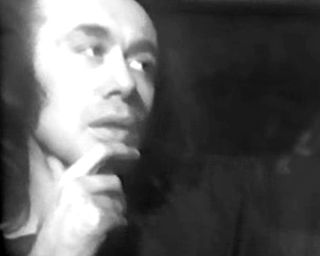
Vito Acconci was an American performance, video and installation artist, whose diverse practice eventually included sculpture, architectural design, and landscape design. His performance and video art was characterized by "existential unease," exhibitionism, discomfort, transgression and provocation, as well as wit and audacity, and often involved crossing boundaries such as public–private, consensual–nonconsensual, and real world–art world. His work is considered to have influenced artists including Laurie Anderson, Karen Finley, Bruce Nauman, and Tracey Emin, among others.

Robert Walter Irwin was an American installation artist who explored perception and the conditional in art, often through site-specific, architectural interventions that alter the physical, sensory and temporal experience of space.

The Sam Hill Memorial Bridge, also known as the Biggs Rapids Bridge, is a steel truss bridge in the northwest United States that carries U.S. Route 97 (US 97) across the Columbia River between Biggs Junction in Sherman County, Oregon, and Maryhill in Klickitat County, Washington. It was named in honor of the early bridge proponent Sam Hill, the builder of the nearby Maryhill Museum of Art.
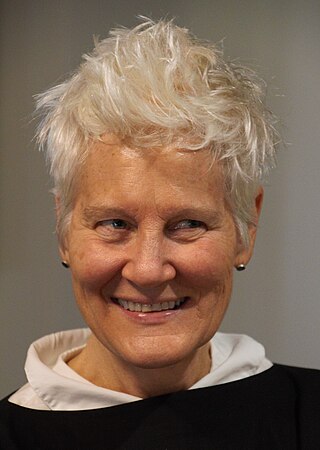
Ann Hamilton is an American visual artist who emerged in the early 1980s known for her large-scale multimedia installations. After receiving her BFA in textile design from the University of Kansas in 1979, she lived in Banff, Alberta, and Montreal, Quebec, Canada before deciding to pursue an MFA in sculpture at Yale in 1983. From 1985 to 1991, she taught on the faculty of the University of California at Santa Barbara. Since 2001, Hamilton has served on the faculty of the Department of Art at the Ohio State University. She was appointed a Distinguished University Professor in 2011.
Ed Carpenter is an artist specializing in large-scale public sculptures made of glass. His work can be found in conference centers, libraries, and airports.

Ron Arad, is a British-Israeli industrial designer, artist, and architectural designer.

The Enfield Shaker Museum is an outdoor history museum and historic district in Enfield, New Hampshire, in the United States. It is dedicated to preserving and sharing the history of the Shakers, a Protestant religious denomination, who lived on the site from 1793 to 1923. The museum features exhibitions, artifacts, eight Shaker buildings and restored Shaker gardens. It is located in a valley between Mount Assurance and Mascoma Lake in Enfield.
Matthew Dalziel and Louise Scullion, known professionally as Dalziel + Scullion, are a Scottish artist duo. Dalziel and Scullion have worked in collaboration since 1993. Their studio creates artworks in photography, video, sound and sculpture that explore new artistic languages surrounding the subject of ecology.
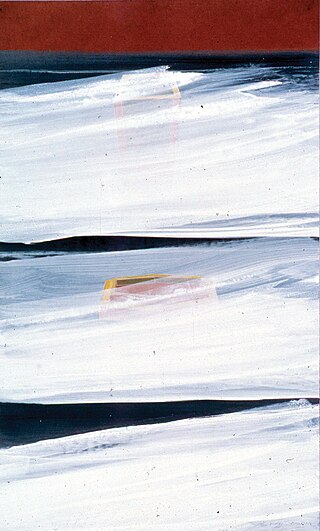
Ron Wigginton is an American artist and landscape architect. His paintings and sculptures are found in West Coast museums and many private collections. His landscapes are known for their narrative and aesthetic qualities, and his artwork typically involves and explores human perceptions of natural and built landscapes. Wigginton is considered to be one of the first Landscape Architects to approach the design of a landscape as a conceptual work of art, for which he has received international recognition through publication and awards.
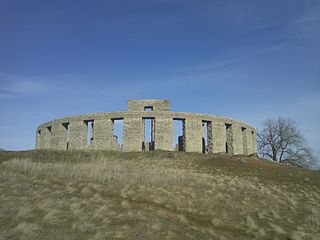
The Maryhill Stonehenge is a replica of England's Stonehenge located in Maryhill, Washington, United States. It was commissioned in the early 20th century by the wealthy entrepreneur Sam Hill, and dedicated on July 4, 1918 as a memorial to the people who had died in World War I.

Dror Benshetrit is an American artist, designer and inventor based in New York City. He opened his studio Dror in 2002 in New York and focuses on product, interior, installation and architectural design. His major works include a structural support system named Quadror, Galataport Masterplan in Istanbul, Türkiye, and the Cappellini Peacock chair. His studio has partnered with companies, developers, and institutions such as Alessi, Bentley, Tumi, Levi's, Boffi, Louis Vuitton, and Target. Dror's work is in the permanent collections of major museums in North America, Europe and the Middle East, including the Metropolitan Museum of Art.

Richard C. Reames is an American artist, arborsculptor, nurseryman, writer, and public speaker. He lives and works in Williams, Oregon.

Paul Housberg is an American glass artist recognized for his use of fused and kiln formed glass as an architectural medium. He currently resides in Jamestown, Rhode Island.
LOT-EK is a design studio based in New York, known for its innovative approach to architecture and design through the adaptive reuse of industrial materials. Founded in 1993 by Italian architects Ada Tolla and Giuseppe Lignano, LOT-EK has been involved in a wide range of projects, including residential, commercial, and institutional projects both in the US and internationally. LOT-EK has also undertaken projects for major cultural institutions and museums, such as MoMA, the Whitney Museum, the Guggenheim, the MAXXI and many more.
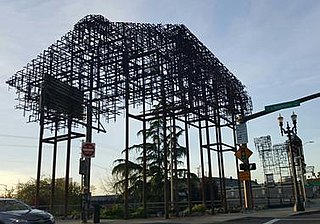
Inversion: Plus Minus is a pair of outdoor sculptures designed by artists and architects Annie Han and Daniel Mihalyo, located in southeast Portland, Oregon. The sculptures, constructed from weathered steel angle iron, are sited near the Morrison Bridge and Hawthorne Bridge along Southeast Grand Avenue and represent "ghosts" of former buildings. The installation on Belmont Street emphasizes "negative space" while the sculpture on Hawthorne Street appears as a more solid matrix of metal. According to the artists, the works are reminiscent of industrial buildings that existed on the project sites historically. Inversion was funded by the two percent for art ordinance as part of the expansion of the Eastside Portland Streetcar line and is managed by the Regional Arts & Culture Council.

Mary Miss is an American artist and designer. Her work has crossed boundaries between architecture, landscape architecture, engineering and urban design. Her installations are collaborative in nature: she has worked with scientists, historians, designers, and public administrators. She is primarily interested in how to engage the public in decoding their surrounding environment.
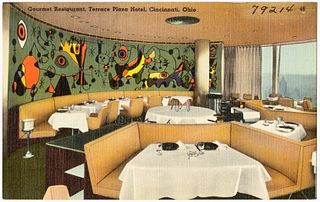
The Gourmet Room or Gourmet Restaurant (1948–1992) was a fine-dining restaurant and iconic modernist space in Cincinnati, Ohio, which received five-star Mobil ratings in the 1970s and was at the time one of the few restaurants in the country so rated. It won multiple dining awards from Holiday.
















